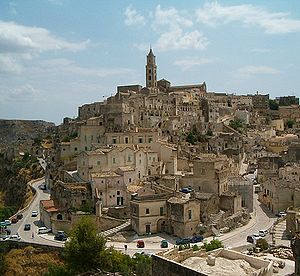 Image via WikipediaThe southern Italian region of Basilicata borders on Campania to the west, Puglia (Apulia) to the east, and Calabria to the south, and has a short coastline on the Tyrrhenian Sea and another on the Gulf of Taranto in the Ionian Sea to the southeast. While it’s not the first place you might think of for a holiday in Italy, the region has a special charm that is slowly being discovered by visitors who are keen to get away from the more touristy parts of Italy.
Image via WikipediaThe southern Italian region of Basilicata borders on Campania to the west, Puglia (Apulia) to the east, and Calabria to the south, and has a short coastline on the Tyrrhenian Sea and another on the Gulf of Taranto in the Ionian Sea to the southeast. While it’s not the first place you might think of for a holiday in Italy, the region has a special charm that is slowly being discovered by visitors who are keen to get away from the more touristy parts of Italy.Basilicata offers stunning arid mountain scenery and inland villages, perched on the hills, where time seems to have stood still. On the coast there are charming villages and seaside resorts such as Lido di Metaponto, with its archaeological relics, Marina di Pisticci, Lido di Scanzano, and Lido di Policoro. Remains of the Roman Era can be seen in Venosa along with medieval art. Basilicata is divided into two provinces: Potenza and Matera.
Matera and the sassi
In Matera, the Ridola National Museum holds Paleolithic relics and ceramics that date back to the Neolithic, Bronze and Iron ages. Just outside the city are distinctive ancient settlements, known as sassi, that have been declared a World Heritage Site. These well–preserved settlements have been cut from rock and include over 100 rock churches from Greek-Byzantine Monastic civilizations. Important sassi include Montescaglioso, with its commanding medieval Abbey of S. Angelo; Miglionico, known for its fine Norman castle;
Irsina, famous for the 12th century Monastery of S. Francesco, its crypt decorated with fine frescoes; Tricarico, with its medieval religious buildings; Pisticci, known for its rows of white houses; and Tursi, set above the Sinni River valley, and the nearby lone church of S. Maria d'Anglona. While there are good hotels in Matera, staying in the rock dwellings is a very different experience, and hotels like Hotel Sant'Angelo, made up of 16 historical dwellings that have been reformed into living areas, include all mod cons. Another accommodation alternative in the old town is one of the many B&Bs where you’ll have a chance to interact with locals and enjoy delicious home cooking.
Potenza, the capital of Basilicata, is of pre-Roman origins, and its Saint Gerard Cathedral was rebuilt at the end of the 1700s. The city’s Provincial Archeological Museum houses an important prehistoric collection, an interesting ethnographic section, and numerous Greek and Roman treasures including the Tempietto and the Statuina di Persefone.
One of Potenza province’s most historic towns, Rivello, set on a strategic ridge that overlooks the Noce Valley and Mount Sirino, has a fascinating mixture of Longobard and Byzantine architecture. Also worth visiting are the Convent of Sant’Antonio da Padova and Santa Barbara’s Church. The Byzantine Church of San Michele dei Greci features a Neapolitan school polyptych dating from 1614.
The Vulture area
In the north of the province of Potenza, fertile soils allow the cultivation of excellent grapes and olives. Here the two beautiful lakes of Monticchio lie within an old volcano, not far from the two castles of Frederick II of Swabia at Castel Lagopesole and Melfi. The Norman S. Lucia Church at Rapolla, Venosa, known for its famous Abbey of the Trinità, and Acerenza, with its thirteenth-century cathedral, are additional district architectural attractions.
